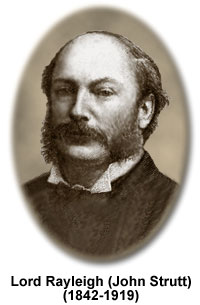Lord Rayleigh (John William Strutt)
(1842-1919)

Lord Rayleigh was a British physicist and mathematician who worked in many disciplines including electromagnetics, physical optics, and sound wave theory. The criteria he defined still act as the limits of resolution of a diffraction-limited optical instrument. Rayleigh wrote over 446 scientific papers, but is perhaps best known for his discovery of the inert gas argon, which earned him a Nobel Prize.
Born John William Strutt, Rayleigh inherited his title when his father died in 1873. Although he was to become the third Baron of Rayleigh, as a young child he was slow to show eminence. He was the eldest of seven children and was almost three years old before he began speaking. Rayleigh's childhood and early education at Eton and Harrow were frequently disrupted by poor health. Hailing from a long line of landowners, Rayleigh was not raised in a scientific family and his predilection for the field was unexpected.
At Cambridge University, however, Rayleigh exhibited strong promise in mathematics and an avocation for photography. He became the top member of his class under the tutelage of Edward Routh, a famous applied mathematician, and then a fellow at Trinity College in 1866. During his undergraduate years, Rayleigh was heavily influenced and inspired by George Stokes, who was a Lucasian professor of mathematics. After graduation, Rayleigh married the sister of the future Prime Minister, Lord Arthur Balfour, and together they had three sons, the eldest of which would eventually follow his father's scientific path.Due to his privileged background, Rayleigh's hard work was a choice rather than a necessity. Yet, he was a natural history professor at the Royal Institution of Great Britain, a Justice of the Peace, Chancellor of Cambridge University, and recipient of many honorary science and law degrees. A fellow of the Royal Society of London, Rayleigh achieved the Royal, Copley, and Rumford Medals and eventually served as president of the organization. In the London Mathematical Society, Rayleigh was also president, from 1878 to 1880, and a De Morgan Medal recipient in 1890. Many physics laws and constants bear his name, as do craters on the moon and Mars. Rayleigh's greatest honor, however, was the Nobel Prize in Physics awarded to him in 1904.
Various scientific achievements earned Rayleigh his renowned reputation. Soon after his marriage, an attack of rheumatic fever almost cost Rayleigh his life. It was on a recuperative trip to Egypt that he began his great work on the theory of sound. The first volume was released in 1877 and a second in 1878. Their discussion of vibration, resonance, and acoustics remains one of the principal accomplishments in the field. Another early undertaking was a mathematical explanation for the light scattering that gives the sky its blue appearance. The Rayleigh Scattering law evolved from this theory and has since become a landmark in the study of wave propagation. Rayleigh also vigorously examined the precision of electrical measures and standardized the ohm.
In optics, the Rayleigh Criterion was chosen by Lord Rayleigh to define the limit of resolution of a diffraction-limited optical instrument. The criterion is defined as the condition that arises when the center of one diffraction pattern (Airy disk) is superimposed with the first minimum of another diffraction pattern produced by a point (or line) source equally bright as the first. For a microscope under this condition, a 26.5 percent dip in brightness appears between the two maxima, giving rise to the sensation (or probability) of peak separation.
The work that was to become Rayleigh's most famous stemmed from his fastidious attention to detail. His discovery of argon was principally due to the detection of a minute inconsistency in density between atmospheric nitrogen and chemical nitrogen. Instead of trying to rid himself of the discrepancy, Rayleigh attempted to amplify it. The difference between the two substances was that one was completely derived from air, while the other partially from ammonia. He substituted oxygen for air in the chemical derivation method so that all of the resultant nitrogen would be derived from ammonia. Rayleigh observed that the nitrogen attained from the ammonia was lighter than that derived from air. He then deduced that the phenomenon transpired because there was a heavier gas than nitrogen in air. Isolating the element proved extremely difficult, however, but Rayleigh eventually succeeded. The gas was named argon, the Greek word for inactive, because it refused to combine chemically with other substances.
